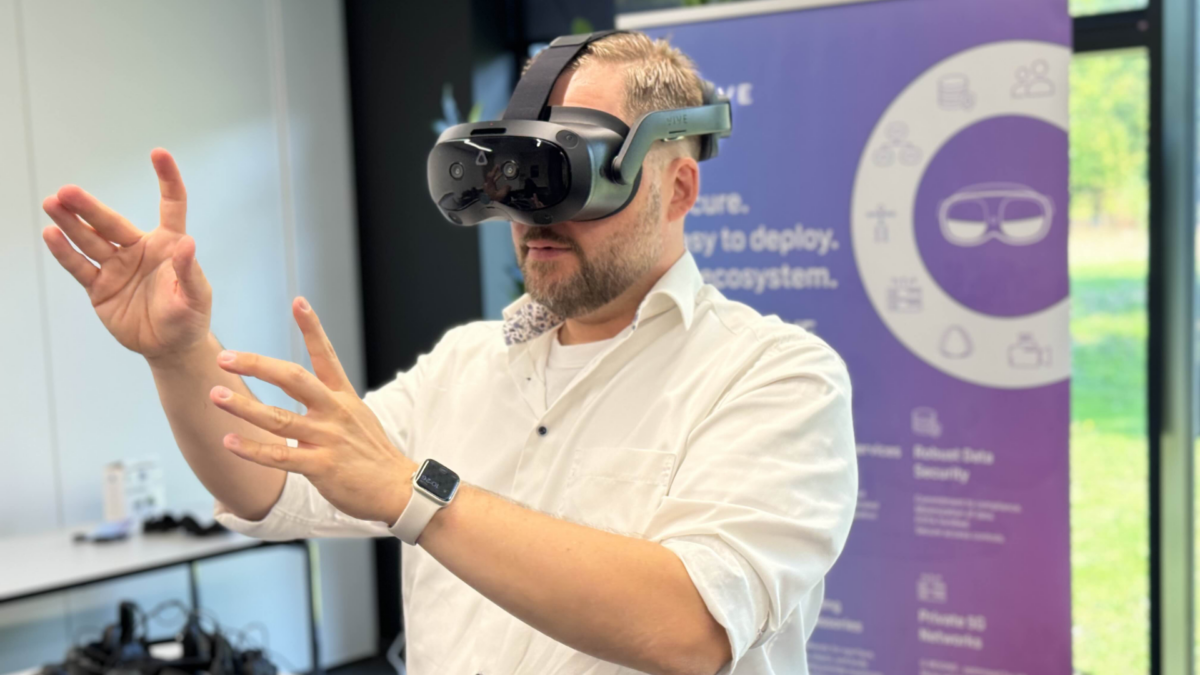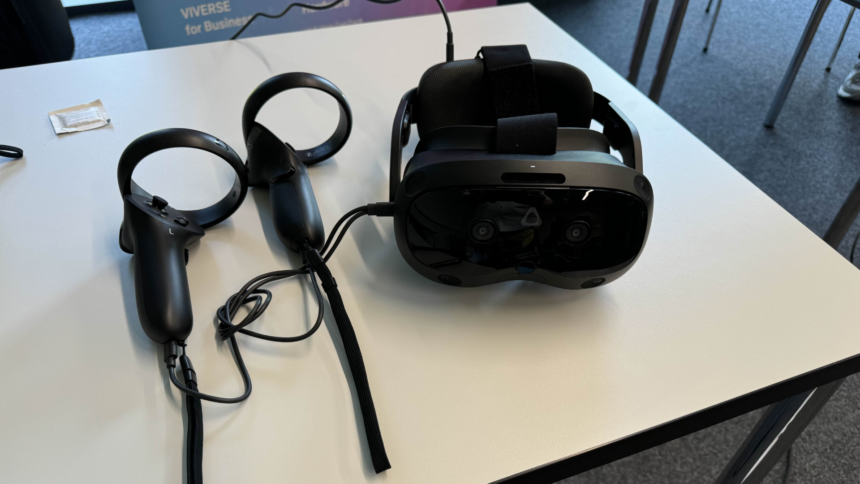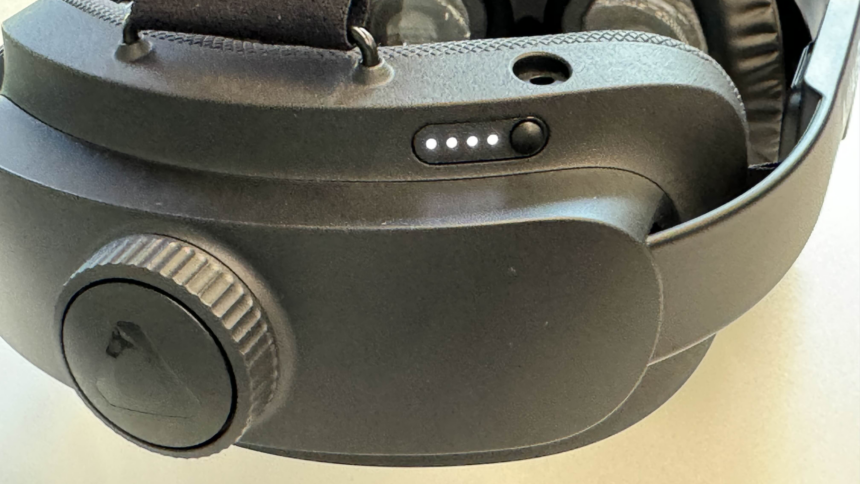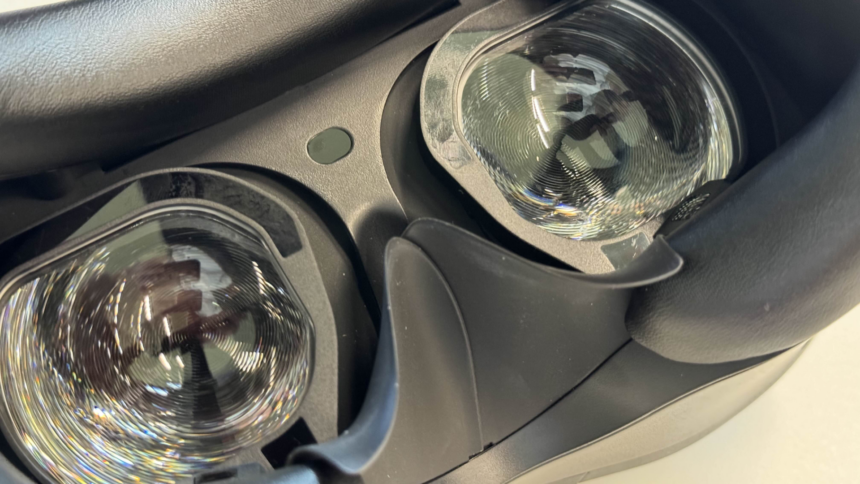HTC Vive Focus Vision hands-on: Perfect for business customers, but not for PC VR gamers

The HTC Vive Focus Vision is a great B2B headset. I explain why in my hands-on.
HTC has unveiled the HTC Vive Vision — an upgrade to the Vive Focus 3 with core elements that are sure to appeal to the business community. I got to try out the new headset at the recent Shift Medical, an XR medical conference in Heidelberg, Germany, where we were on hand to share our expertise.
Content
Who is the Vive Focus Vision for?
HTC fulfilled many of the industry's wishes with the Vive Focus 3 in June 2021: A replaceable battery in the back of the head, a practical design, good weight distribution, decent standard speakers, and grayscale pass-through for easy orientation when no application is running. In addition, the XR2 chip was installed as the gold standard at the time. At MIXED, the Vive Focus 3 was rated as a good device at the time, but showed weaknesses in its optics due to the built-in Fresnel lenses.

HTC continues to rely on tracking rings for the VR controllers of the Vive Focus Vision. | Picture: Christian Steiner
Today, three years later, HTC is still using the same lenses and high-resolution 2448 × 2448 display for the Vive Focus Vision. This means that the lens refraction that Ben found annoying in his review is still there. It never bothered me that much, but I understand that VR enthusiasts in particular had to swallow hard when it was announced. This much is certain: despite the Display Port connection, the Vive Focus Vision is not a VR headset for the racing sim fans among you who are looking for maximum edge-to-edge clarity and the largest possible field of view.
Although HTC's marketing for the Vive Focus Vision is aimed at PC VR gamers this time around, the new headset remains a B2B device at its core. The Focus Vision is primarily aimed at companies looking for reliable and functional XR devices to easily advance research and development based on open drivers and SDKs, or to deploy XR devices in large-scale environments such as location-based entertainment scenarios. In other words, where the goal is to quickly get people wearing VR headsets without much experience with the technology.
Vive Focus Vision is an important upgrade to the Vive Focus 3
Let me explain what I love about this device and why. In the "race" to build the best headsets on the market, HTC has chosen to build solution-oriented devices for enterprises. The HTC Vive Focus 3 is in use in most Location Based Entertainment (LBE) offices around the world. Both in standalone use (i.e. using the XR2 processor) and in very stable WLAN streaming, with dedicated LBE software to manage and organize multiple devices in large tracking rooms. Let's take a look at the advantages over the Focus 3.
Improved stability
This is most noticeable in the form of metal headband brackets at potential break points, which make the headset easier to handle. In general, I really like the feel of the Vive Focus Vision, even though others have called it a "plastic bomber".
It's just that the plastic is a little more flexible, the big design gives more room for airflow, and you can actually leave your glasses on all the time because it fits inside the headset. And the target audience only wears the headset for an average of 30 minutes at a time before taking a break. It is also comfortable for my very large head, where I often have problems with other Asian manufacturers.
Excellent 3D color pass-through image
Currently with very slight warping, but this can be fixed with software updates. I was able to grasp real objects in my environment without any problems (my personal coffee cup grasping test). I am sure that the pass-through quality will make it possible to realize good AR applications in the entertainment sector or to start new research projects. This will enable new offerings and new or returning customers in the XR entertainment industry, which is where my heart lies.
Battery is now truly hot swappable
While the Vive Focus 3 would still run out of power when changing the battery, Focus Vision has added a small additional battery that provides power for about 20 minutes. Enough to power the headset with a freshly charged battery while in use, all built into the hardware as standard. Awesome!

The hot swap battery and the metal ring for the headband are clearly visible. Not to be seen: The integrated mini battery that provides 20 minutes of power for the hot swap. | Picture: Christian Steiner
Eye Tracking integrated as standard
A big advantage! Standard means that developers can now reliably provide these features without having to hope that potential customers will buy an optional module as additional hardware, as was the case with Focus 3, for example. This greatly reduces market fragmentation. I hope that all manufacturers will soon offer eye tracking as standard in all their devices.
Focus Vision's eye tracking is reliable and easy to implement thanks to OpenXR. With the business audience in mind, the system adjusts the IPD (interpupillary distance) to the user immediately upon putting on the device, without the need to ask. This saves a lot of explanation and calibration time.
Unfortunately, the lenses with their small sweet spot spoil the otherwise smooth setup experience. Even though the horizontal distance is set automatically, I still have to make a few adjustments by moving the headset up and down.
Better hand tracking with infrared
Thanks to the infrared emitters on the front of the headset, hand tracking now works even in low light conditions. The infrared LEDs illuminate the hands in a spectrum of light that is invisible to us, which can be detected by the cameras.
The hand tracking was absolutely usable for me. In direct comparison to Meta, there is still a noticeable difference, but it is so small in the application scenarios of the Focus devices that it would not make a difference to me in professional use.
Very good PC streaming
What I wasn't able to test was the new lossless streaming via Display Port Link via USB-C. The use case can be found in the automotive sector, for example, where a lossless display is required.
During my hands-on, the image was streamed from the PC to the VR headset via Wi-Fi and I found it to be very good. Once the final drivers are available, the streaming image should look even better.

There is no upgrade for the lenses. Instead, you can clearly see the permanently installed eye tracking around the
Fresnel lenses. | Picture: Christian Steiner
My hands-on verdict on the HTC Vive Focus Vision
As mentioned at the beginning, this headset is not for XR enthusiasts. Even if HTC advertises it differently and wants to grab a piece of the consumer market, I see these VR headsets being used primarily in the business sector with customer contact.
They are rugged, easy to use, and designed for continuous use. I think the evolution from Focus 3 to Focus Vision with better pass-through, more stable processing in critical areas and permanent eye tracking is a good decision.
The use of the 3 year old XR2 instead of the current XR2 Gen 2 is a shame, but I think HTC knows its numbers and knows that its target audience is either using highly customized entertainment software anyway, or will switch to PC streaming in a heartbeat. Both are true for my customers who might be interested in this device.
The technical capabilities of the XR2 are rarely pushed to their limits in research projects or education. If it is, it is usually due to poor optimization or unfinished applications. Even an XR2 Gen 2 would not change that.
I think it's great that HTC is another consistent manufacturer in this market and is consciously trying to differentiate itself from other devices to find its niche within the niche. I wish them good luck because this is precisely what the VR market needs.
Note: Links to online stores in articles can be so-called affiliate links. If you buy through this link, MIXED receives a commission from the provider. For you the price does not change.